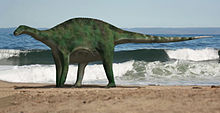Brachytrachelopan
| Brachytrachelopan | ||||||||||||
|---|---|---|---|---|---|---|---|---|---|---|---|---|

Skeletal reconstruction of brachytrachelopan |
||||||||||||
| Temporal occurrence | ||||||||||||
| Upper Jurassic ( Tithonian ) | ||||||||||||
| 152.1 to 145 million years | ||||||||||||
| Locations | ||||||||||||
| Systematics | ||||||||||||
|
||||||||||||
| Scientific name | ||||||||||||
| Brachytrachelopan | ||||||||||||
| Rauhut et al., 2005 | ||||||||||||
| Art | ||||||||||||
|
Brachytrachelopan is a genus of sauropod dinosaur from the family of dicraeosauridae that in the late Jurassic ( Tithonian ) in what is now Patagonia lived (South America).
In comparison with other sauropods, which were characterized by their very long necks, the neck of Brachytrachelopan with a length of 150 cm reached only 75% of the body length; thus this animal had the shortest neck of all known sauropods. The only kind and type species , brachytrachelopan mesai , was established in June 2005 by a German- Argentine research group led by the paleontologist Oliver Rauhut (Bavarian State Collection for Palaeontology and Geology, Munich) in the journal Nature first described . The animal is known only through a single partial skeleton.
Features and paleoecology
The Dicraeosauridae consists of three genera, which are distinguished from other sauropods by their relatively short necks - in addition to Brachytrachelopan , these are Amargasaurus from the Lower Cretaceous Argentina and Dicraeosaurus from Tanzania (Africa). The neck of Brachytrachelopan was about 40% shorter than that of the other two genera. Brachytrachelopan measured less than 10 meters in length, with the strongly interconnected vertebrae indicating that it must be an adult animal.
Rauhut et al. note that within the Dicraeosauridae the trend towards a shortened neck can be seen, in contrast to the trend towards increasingly longer necks in other groups such as the Diplodocidae . This shows that the dicraeosaurids occupied a different ecological niche and may have specialized in certain food sources. The vertical mobility of the neck of Brachytrachelopan was severely restricted, which is why a feeding height of 1 to 2 meters is assumed for this species. Rauhut et al. suspect that dicraeosaurids occupied the same ecological niche as large iguanodonts . The latter were absent on the southern continents during the Upper Jurassic, but were common in North America, where again the dicraeosaurids were absent.
From the discovery of brachytrachelopan in Patagonia and the anatomical differences of the dicraeosaurids, the researchers also conclude that this group developed relatively quickly in the Middle Jurassic and was widespread and diverse even before the complete breakup of the continental plates of Africa and South America .
Find and naming
The partial skeleton (catalog number MPEF -PV 1716) was discovered by the sheep farmer Daniel Mesa on a hill 25 km north-northeast of Cerro Cóndor in the province of Chubut . The bones were found in an outcrop of fluvial sandstone , which geologically belongs to the Cañadón-Calcáreo formation . Although the remains are very incomplete, the bones were in an anatomical bond. Rauhut's team was able to recover 20 related vertebrae from the neck and trunk area, as well as ribs, the pelvis and parts of the femur and tibia of a hind leg. The remaining bones may have been destroyed by erosion many years before the skeleton was discovered.
The name for the new genus and species consists of the Greek word brachytrachelos (for short neck ), the name of the shepherd god Pan (because the fossil was discovered by a shepherd) and the family name of the discoverer ( Mesa ); it means: Mesa's short-necked shepherd god .
literature
- Oliver WM Rauhut , Kristian Remes, Regina Fechner, Gerardo Cladera, Pablo Puerta: Discovery of a short-necked sauropod dinosaur from the Late Jurassic period of Patagonia. In: Nature . Vol. 435, No. 7042, 2005, pp. 670-672, doi : 10.1038 / nature03623 .
Web links
Individual evidence
- ^ Dougal Dixon : The World Encyclopedia of Dinosaurs & Prehistoric Creatures. Lorenz, London 2008, ISBN 978-0-7548-1730-7 , p. 220.
